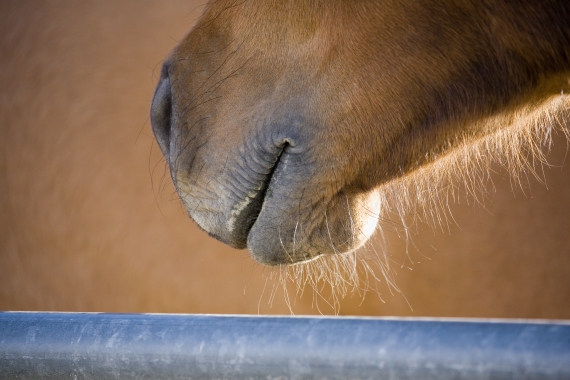Equine Herpesvirus
Equine herpesvirus type 1, also known as EVH-1, rhinopneumonitis or rhino, is a highly infectious disease in the equine population. The virus is easily spread by direct nose-to-nose contact, aerosolized nasal secretions up to 25 feet, contaminated tack, equipment and dirty hands.
It causes respiratory disease, neonatal mortality and, in rare cases, neurologic disease. A horse can be exposed to herpesvirus and pass the virus onto other horses, without showing any signs of disease.
What is Equine Herpesvirus Type 1?
There are 5 strains of equine herpesvirus but one of the more virulent strains, EVH-1, has been associated with a neurologic form of illness called equine herpesvirus myeloencephalopathy (EHM). EHM is a disease reportable to the state veterinarian, and quarantine of the farm or facility will be mandated until after the the virus is shed.
The virus can remain within the horse and go into remission, then reactivate in shedding of the virus in nasal secretions. This reactivation most commonly occurs during times of stress; weaning, travel, or change of environment.
What to Look For
- Fever of 102°F or above; the most common initial symptom.
- Respiratory signs, nasal discharge, and cough.
- Neurologic signs: paresis and ataxia, or weakness and incoordination.
- Recumbency; or laying down then being unable to rise without assistance.
- Difficulty urinating or dribbling urine.
- Late gestation neonatal mortality.
The incubation period is variable. It recommended to watch any horse for 14 days after returning from competition. Most horses will show signs of a respiratory disease within 4-7 days.
Diagnosis
A tentative diagnosis can be given based on history and signs of respiratory disease. A definitive diagnosis is made after a nasal swab and blood sample, are sent to a lab. There they are analyzed by polymerase chain reaction (PCR). This test identifies any viral DNA in the nasal secretions or blood, and differentiates between the neurologic strain.
Treatment
Most horses with the respiratory form of disease require no specific treatment. The farm or facility should adhere to good hygiene protocols to minimize spread. Horses with EHM are treated with supportive care, anti-inflammatory medications and nutritional support. Use of the antiviral drug, valacyclovir, may be used however the efficacy in horses is still being studied.
Farm Management
To decrease the spread of this highly infectious disease, practice good hygiene and biosecurity protocols.
- Try to isolate any horse that shows any of the above clinical signs at least 10-12 feet away from other horses.
- Wash hands using an alcohol based sanitizer between horses.
- Wash and disinfect all equipment including: buckets, bits, tack, twitches, lead ropes, water hoses, manure picks, wheelbarrows. A dilute bleach solution will work well.
- Feed and clean in the order of non-exposed to exposed to infected.
Vaccination
Vaccination does not prevent infection but does reduce the amount of virus that is shed. Immunity from the vaccine can be short lived therefore it is recommended to administer boosters every 3-4 months in horses that are traveling often.
For optimal immunity, vaccination should be performed within 30-45 days of traveling to an event but not within 7 days leading up to the event. There are no vaccines available to prevent the neurologic form of herpesvirus infection. It is also highly recommended that at-risk pregnant mares receive vaccination at months 5, 7, and 9 of gestation to prevent abortion.
Immune Stimulants
Stress decreases the ability of the immune system to fight disease and is known to increase viral shedding of EHV-1. It has been recommended to use immune stimulants prior to traveling to shows. The preferred product being Zylexis, a 3 shot series used on day 1, 3 and 10. The last dose must be given within several days of traveling.
Take Home Message
If you feel your horse has been exposed to EHV-1:
- Contact your veterinarian
- Isolate the horse from nose-to-nose contact.
- Monitor the rectal temperature two times per day.
- Do not move horses off of your property for 28 days.
- Do not allow new horses onto your property for 28 days.




